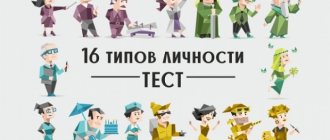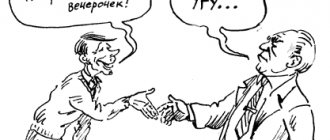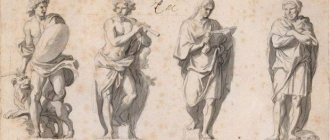Hello Habr! Analyzing user data for marketing and advertising purposes, we decided to investigate the influence of a user's personality type on how they respond to an advertisement. We decided to take as a basis perhaps the most popular typology of personality traits, MBTI (Myers-Briggs Type Indicator), known since the mid-20th century. Many large Western companies use MBTI tests when hiring or when forming a team to work on projects. But we are, of course, not interested in the user’s readiness for team work, but in the influence of his personality type on the desire to click on the banner. Therefore, the question we explored is: “Can personality types influence CTR in advertising campaigns?”
In this article I will talk about how we did it.
Myers-Briggs typology
The Myers-Briggs typology includes four characteristics.
- E—I—direction of vital energy:
E (Extraversion)—to the outside world; I (Introversion, introversion) - on the inner world; - S-N - way of orienting in a situation:
S (Sensing, common sense) - focusing on specific information; N (iNtuition, intuition) - orientation towards generalized information; - T-F - basis for decision making:
T (Thinking) - rational weighing of alternatives; F (Feeling) - making decisions on an emotional basis; - J—P—method of preparing decisions:
J (Judging)—preference to plan and organize information in advance; P (Perception, perception) - preference to act without detailed preliminary preparation, focusing more on circumstances.
The combination of the characteristics described above gives the designation of one of 16 types, for example: JTSE.
Determination of personality type
To determine the user's personality type, we built four classifiers, one for each characteristic.
For the training sample, we used information from one of our partner sites; on this site, the user fills out a questionnaire that determines his personality type. The sample size is about ten thousand users. The dependent variable in each of the classifiers is the feature classes. For example, for the EI characteristic: I - positive class (1), E - negative class (0).
As independent variables, we used the history of user behavior on the Internet (pages visited) for the period preceding the test on the partner site. The address of each page visited is represented in the form of tokens: words ranging from three to ten characters long. For example, the address habrahabr.ru/company/dca/blog/260845 is converted into the following set of tokens: ['http', 'habrahabr', 'company', 'dca', 'blog'].
After this, all data is randomly divided into a training set (37.5%), a feature engineering sample (37.5%) and a test set (25%).
The feature engineering process is similar to the one we use for hierarchical classification of sites, which is described in our previous article, however, I will describe it below.
What is personality typing
Personality typing is a system of categorizing people according to their tendency to think and act in certain ways.
Image: unsplash.com
Isabel Briggs Myers and Katherine Briggs expanded on Jung's ideas to create a more complete framework of individual typing. Myers and Briggs suggested that there are four key measurement scales that can be used to classify people:
- I
introversion (Introversion) /
E
extraversion (Extraversion) - S
sensation (Sensing) /
N
intuition (iNtuition) - T
thinking (Thinking) /
F
feeling (Feeling) - J
Judging /
P
Perception
Each of the four scales was described as a dichotomy, or a choice between two styles of existence.
Myers and Briggs described this as "preference" and suggested that the individual should independently determine their preferred style along each of the four dimensions. The sum of a person's four preferred styles becomes their personality type.
Briggs and Myers theorized that human preferences on each of the four dimensions would combine to create predictable patterns in thinking and behavior, such that people with the same four preferences would have many similarities in how they approached their lives, from hobbies to they choose, up to a job that might suit them.
Description of the meanings of letters in personality type
Happy shopping on iHerb!
Each of the four letters in the personality type code represents a preference in a style of thinking or behavior.
E/I introversion or extraversion
The introversion/extroversion dimension describes where a person gets and how he gets his energy.
- I— Introverts
“expend” energy through action: they prefer to think, then act, and then think again.To restore energy, introverts need solitude and a break from activity.
- E— Extroverts
They derive energy from action: they tend to act, then reflect, and then act further. If they are inactive, their motivation tends to decrease.To restore their energy, extroverts need breaks from alone time.
S/N feeling or intuition
The sensation/intuition dimension describes how a person collects and processes information (perception). How new information is understood and interpreted.
- S— Sensory
are more likely to trust information that is present, tangible, and concrete: that is, information that can be understood through the five senses.They tend to be distrustful of premonitions that seem to come “out of nowhere.” They prefer to look for details and facts. For them, the meaning lies in the data.
- N— Intuits
tend to trust information that is less dependent on the senses, that can be associated with other information (either remembered or discovered by searching for a broader context or pattern).They may be more interested in future opportunities. For them, meaning lies in the underlying theories and principles that appear in the data.
T/F thinking or feeling
The thinking/feeling dimension describes how people make decisions (judgments).
- T— Thinkers
tend to make decisions from a more detached perspective, measuring a decision by what seems reasonable, logical, causal, consistent, and consistent with a given set of rules.Thinkers typically have trouble interacting with people who are inconsistent or illogical. They are concerned about the truth and consider it more important.
- F - Feelers
typically come to decisions by associating or empathizing with a situation, looking at it from the inside, and weighing the situation to achieve balance and greatest harmony, consensus, and fit, taking into account the needs of the people involved.
J/P judgment or perception
The judgment/perception dimension describes how people approach their lives: in a structured or open, flexible manner.
- J— Judging
approach life in a structured manner, creating plans and organizing their world to achieve their goals and desired results in a predictable manner.Gain a sense of control by taking responsibility and making choices earlier. They are self-disciplined and decisive, striving for completion in their decisions.
When they ask for something, they are specific and expect others to do as they say. They like to be experts.
- P— Perceivers
perceive structure as more restrictive than enabling.They prefer to keep their choices open so they can change their minds. Gain a sense of control by keeping their options open and making choices only when necessary.
They tend to be curious and love to expand their knowledge, which they freely admit to be incomplete. They are tolerant of other people's differences and adapt to any situation.
Feature engineering
For each token in the feature engineering sample, we calculate the following characteristics
- how many times the token was encountered (total_number);
- how many times the token was encountered, provided that the user belongs to a positive class (true_number);
- how many times the token was encountered, provided that the user belongs to a negative class (false_number);
Next, we calculate the distributed grade (dg) metric for each token. We select twenty tokens with the highest value of this metric for each class. As a result, we get forty features. Feature values are conditional probabilities of a token belonging to a class: true_number to total_number and false_number to total_number.
Characteristics of the resulting classifiers
For classification, we used the Gradient Boosting Classifier from the scikit-learn library.
To assess the quality of the classifiers, we analyzed the area under the ROC curve. ROC curve is a graphical characteristic of the quality of a binary classifier. The curve reflects the dependence of TPR (true positive rate) on FPR (false positive rate). where TP is true positive, FP is false positive, FN is false negative, TN is true negative.
The area under the ROC curve AUC (Area Under Curve) is a characteristic of classification quality: the higher the AUC value, the better the classification model.
In the process of selecting parameters, we managed to increase this metric from 0.63 to 0.77, using a lattice search for the parameters n_estimators (number of trees) and max_depth (depth of trees).
Table 1 shows the final values of the area under the ROC curve for each classifier. And in the figure below the ROC curves themselves are plotted. Table 1: Areas under the ROC curve of classifiers
| EI classifier | 0.763 |
| SN classifier | 0.793 |
| TF classifier | 0.768 |
| JP classifier | 0.768 |
Testing on real data
Well, now we get to the most interesting part.
Namely, before answering the question “Can personality types influence CTR in advertising campaigns?” To understand this, we analyzed data from one of our advertising campaigns. However, no restrictions were placed on the audience of this campaign. In total, this campaign generated more than 89 million impressions. For the analysis, we used about 30,000 unique users who clicked on the banner and 300,000 unique users who were shown the banner at least once.
Next, we estimated the user's probability of belonging to one of the classes for each characteristic of our typology. Then, we took 10% of users with the highest probabilities and 10% with the lowest probabilities. In each of the groups, we estimated the CTR and constructed 95% confidence intervals for it using Wilson’s formula (wilson score interval)
where n is the sample size, where k is the number of clicks, and is the alpha quantile of the standard normal distribution.
As can be seen from Table 2, for the EI and TF characteristics, the difference in ctr is more than 20% and is statistically significant.
While for the SN and JP characteristics the difference in CTR is not statistically significant. Thus, there are advertising campaigns in which personality types affect CTR. Table 2: CTR estimates and confidence intervals
| Extraversion Introversion | 8.7 11.4 | (8.4, 9.0) (11.1, 11.8) |
| Sensing Intuition | 10.2 10.0 | (9.9, 10.6) (9.7, 10.4) |
| Thinking Feeling | 9.5 12.5 | (9.1, 9.8) (12.1, 12.9) |
| Judging Perception | 10.0 10.7 | (9.6, 10.3) (10.3, 11.1) |
It is worth noting that this is the result for a specific advertising campaign, which is largely determined by what exactly we advertised within it, the appearance of the banners, etc. Perhaps in other campaigns, other characteristics would have had a significant difference in CTR.
Take an online test of 20 questions
The Myers-Briggs test, along with many other tests popular in world practice, is included in the “Self-Knowledge” course. After completing it, you can get a detailed description of your personality, strengths and weaknesses, and inclinations in order to better understand yourself and use this knowledge for self-development.
The test below will determine which “pole” for each dichotomy a person is more inclined to. The test contains 20 questions: 5 questions for each descriptor. It is an odd number of questions for each scale that makes it possible to get your inclination towards one or another pole (an even number would make it possible to get an intermediate result: 50 to 50).
Before starting the test, it is important to understand the following things:
- No questions in any questionnaire, even the most detailed, can cover all of a person’s behavior. This test allows only to “outline the framework” and indicates a bias, and not the comprehensive dominance of some properties over others.
- Regardless of belonging to any type, each person uses both poles of preferences in everyday life, but to varying degrees. For example, we can be sociable with good friends, but more often we are introverts.
- When answering a question, choose the option that seems most preferable and comfortable for you in most life situations. If you don't like both options, then choose the least unattractive option.
- By taking the test, you will not only find out your personality type, but also receive a short explanation of the result. Don't forget to answer all the questions; it's best to go in order.
We will be glad if you indicate your personality type in the comments and tell us your opinion and impressions about the test. Also pay attention to our training in psychology, as well as the MBTI test to determine the type of creativity.
What's next
The 20% difference in CTR between different classes inspires us to apply knowledge about personality types when conducting advertising campaigns.
In the near future, we plan to make eight user segments available for targeting advertising campaigns - two for each characteristic. In addition, we are faced with the task of learning to understand, before the start of an advertising campaign, what type of personality the information from it will be most interesting to. But this is not the only application of the segments we obtained. Information about personality types can be used in almost all areas of business.
For example, when running a large recruitment campaign (usually done by fast food chains, manufacturing plants and retail chains), you can target advertising to people with certain characteristics. Thus, already at the entrance, the conversion funnel narrows and the budget is significantly saved.
Less obvious: knowing the psychotype of site users, the company can adapt its appearance and content to better meet expectations and, as a result, increase sales.
In fact, any business whose work is based on interaction with a large number of clients through digital channels will be able to use this knowledge to optimize its processes and build more personalized communications.
M.D. Krymov, I.A. Kochuk
The article discusses the development of Jung's typology. The American and domestic branches of the development of his ideas are compared. The overlaps and divergences between socionics and MBTI are discussed.
Key words: Jung, socionics, MBTI, Myers-Briggs typology, tests, theory, distribution.
As you know, the analogue of socionics in the United States is the Myers-Briggs typology, which is often briefly called MBTI after the name of the Myers-Briggs Type Indicator (MBTI) questionnaire. Today it is an officially recognized test and scientific direction in psychology. More than 3 million typings are carried out per year in the USA alone; 86 of the 100 largest companies form teams taking this typology into account.
Developing independently and, accordingly, having differences in terminology and models, socionics and MBTI still represent one scientific direction and coincide in the main thing: types and their descriptions. At the same time, many of the obstacles that socionics faces today are already a passed stage in the development and recognition of MBTI.
Socionics and MBTI, being in unrelated, parallel development, repeat the history of many exact and natural sciences, which for a long time developed on opposite sides of the Iron Curtain or oceans. Examples of such development can be aircraft rocket science, cybernetics, genetics and many other sciences. Today we see that MBTI is more focused on practical application, while socionics is more focused on deep study of the theoretical part, as well as on the development of additional models.[16]
What is socionics?
T.N. Prokofiev describes the basis of socionic theory as follows: “The approach of socionics is based on the idea of K.G. Jung about the presence of mental functions in a person, each of which performs its own work. K.G. Jung identified four mental functions: thinking, feeling, intuition, sensation, which can be considered as channels for perceiving, processing and transmitting information of varying quality. By analogy with the natural metabolism of cells, the flow of information coming to a person is split by the psyche into separate components. But not just any one, but a specific channel corresponding only to it is responsible for receiving and processing each of these components.”
In this regard, A. Augustinavichiute writes:
“The discovery of C. G. Jung is the discovery of a mechanism for selecting signals perceived by the psyche. This mechanism can be called the information metabolism (IM) code or the rules of the language through which information is transmitted.” Therefore, the second name of Socionics is “the theory of types of information metabolism.”
In socionics, Jung's mental functions are renamed by A. Augustinavichiute, and thinking, feeling, intuition and sensations are called logic, ethics, intuition and sensory, respectively.
“By presenting, following Jung, each of the four functions in an extroverted and introverted setting, Aushra received eight mental functions, which correspond to eight aspects of information flow. The combination of computer science and psychology made it possible for Aušra Augustinavičiūta to build models of the structure of psychological types. Model A is built in accordance with the position of S. Freud's psychoanalysis on the structure of the psyche, including consciousness and the unconscious: ego - superego - id. The structure is depicted as two rings of functions. The mental ring reflects primarily the social in a person, the vital ring reflects the biological. The socionic model serves for reliable diagnosis of psychological types, as well as for determining the relationships between personality types” [5].
What is MBTI?
In 1921 K.G. Jung published a book called Psychological Types, the academic language of which was difficult for the layman to understand, and, accordingly, few could apply his ideas in practice. However, during World War II, two American women, Isabel Briggs Myers and her mother, Katherine Briggs, developed an accessible way to use Jung's ideas in everyday life. Their goal was to give people the ability to easily determine their type without diving deeply into Jung's academic theory.
The Myers-Briggs Indicator has been the subject of extensive scientific analysis and study, and considerable evidence has been collected for the validity and reliability of the test (Carlson, 1985; Furnham & Stringfield, 1993). The Myer-Briggs Indicator Form G is based on Jung's teachings about personality types. Typing is carried out in a self-diagnosis format using a test printed on paper. It consists of 94 questions with a choice of one of 2 answer options. Based on these answers, preferences are determined according to the four dichotomies described in Jung’s theory: extraversion/introversion (Extraversion–Introversion), sensory/intuition (Sensation–Intuition), logic/ethics (Thinking–Feeling), rationality/irrationality (Judging–Perceiving). By the way, it should be noted that the Russian word “irrationality” has a negative connotation, corresponding to the Russian “unreasonable”. “Form G” is a marking of the evolutionary development of the questionnaire, which went through several stages of clarifying questions based on the results of a scientific analysis of the methodology and results of this test. Thus, MBTI theory currently defines dichotomies, types (16), and several small groups have been described.
The MBTI is the most popular test in the United States and, according to written sources, in the world. It is mainly used in business and education to work more effectively with students and employees in corporations. The test results are used primarily for career guidance, as well as to determine your leadership style and to form effective teams. Those. Most often, the test is financed not by the person being typed, but by an interested organization. There are special practices and exercises aimed at teaching employees to use their strengths to more effectively solve problems and to better understand the actions and thinking of other team members.
The questionnaire is also informally used during hiring, although the MBTI organization itself is categorically against this and regards it as discrimination. In the USA, the resume does not indicate gender, age, nationality or skin color, because... If denied, the company may be sued for denial on grounds of discrimination, even if the person provided the information themselves. That is, for ethical reasons, the MBTI is considered a tool for improving the inclusion of people in the work process, and not for filtering.
It is important to note that MBTI is not a science, it is a product. It was created to make Jung's type theory accessible to people, and the result is a branded, proprietary test. The test has been developed for decades, tested and verified. But nevertheless, the test itself is a derivative of psychology, including Jungian psychology, which is developing and includes interpretations and analysis of the MBTI test.
The main rise in popularity of MBTI is thought to have occurred in the 1970s, with 1.5 million typings recorded in 1986 and 3.5 million typings in 2011. This means personal paid typing followed by work with a licensed specialist.
Anyone can obtain the right to use the test by completing a four-day training and briefly learning how to interpret its results. The main target audience is personal growth coaches, corporate trainers and psychologists. Psychology in the USA is a licensed profession. Therefore, according to the law, in order to work with clients, you must constantly gain qualification points for professional education and pass exams every 5-10 years. The MBTI is part of a scoring system in psychology.
Similarities and differences
Over the past decades, many attempts have been made to link these two systems. We would like to present the resulting conclusions from an article by Lithuanian researcher Lilita Zelita from 2014 in the journal “The humanities and social studies”.
Lilita Zelita has studied more than a hundred works of socionic researchers and more than sixty works of MBTI specialists. The general conclusion is: “Socionics and MBTI have a common theoretical base (C. G. Jung’s Theory of Psychological Types), a general description of the main dichotomies, partially divergent functional models and common final results (16 types and their characteristics). Both theories do not contradict each other, but are mutually complementary, and thus can be used to better understand oneself and others in everyday situations, in the family, in education, in work.”
That's what it means. All basic dichotomies coincide, several small groups are known in MBTI, the general description of the types coincides with the socionic one.
At the same time, the MBTI also has functional models of each type.
Rice. 1 Type functions in MBTI
For half of the types (extroverts), the models completely coincide with the socionic ones. And the models of introverted types differ from socionic ones (Fig. 1). So, for example, for the ISFP type, which stands for introvert/sensory/feeling/receptive or in socionic terms introvert/sensory/ethical/irrational, i.e. SEI (ISFP, “Dumas”) theoretical model of the order and scope of functions is as follows - the first, dominant function is introverted ethics, and the second, complementary one is extroverted sensing. According to the socionic model, this would correspond to the ESI type (ISFJ, “Dreiser”).[1].
The functions in the MBTI model are defined as follows.
It is important to note that the type in MBTI is determined through the dichotomies of Jung’s basis based on the results of filling out the questionnaire, and the models do not form the basis for further theoretical constructions and practical application.
Lilita Zelita explains the differences in the theoretical layout and descriptions in MBTI and socionics by differences in the types of their founders and key representatives. The language used in type theory is understandable to ordinary people, since its founders - Katherine Briggs, Isabel Briggs Myers and others, were from the humanities club, and their leading functions were ethics and intuition. Socionics was founded by A. Augustinavichiute, and most of its key representatives, including V. Gulenko, G. Reinin, A. Bukalov, T. Prokofieva - from the club of researchers with the leading functions of logic and intuition.
It is important to note that MBTI is considered as self-identification, self-report: a person shows who he wants to be, what interests him. This is done on the basis of independently completing a test of 96 questions within 20 minutes. Additionally, information is provided on the percentage preponderance of the dominant trait. In this way, a person can see which functions are more pronounced, and where the excess or deficiency is insignificant. Often a recommendation is given to look at information about a related type. The test results are then verified by a specialist.
Socionics focuses on assessing the type from the outside, which is more objective, but technically much more difficult. For correct self-diagnosis, a person must not only have a very deep knowledge of socionic theory, Model A, the characteristics of various types and be free from social stereotypes and approved models of behavior, but also understand and know himself well, accept himself as he is. Such requirements make self-diagnosis very difficult and biased. This issue is discussed in more detail in the article by T.N. Prokofieva and V.G. Prokofiev “Puzzle technology. Quality standards for socionic diagnostics.”[7]
This fact - self-diagnosis - explains the difference in assessing the uniformity of the distribution of types among people according to MBTI and socionics. In socionics, as far as we know, it is believed that the distribution is approximately uniform, but in MBTI there are statistics according to which the distribution is uneven. The extreme representatives are the types ISFJ - ethical-sensory introvert - 13.8% of the population, and ENFJ - ethical-intuitive extrovert - 1.5%
A number of articles discussing the complexities of MBTI typing emphasize that the main problem is that the description of types is too simplistic. After all, extroverts are not necessarily noisy and introverts are quiet, but the point is how a person perceives and processes information. Here you can see a direct connection with the concept of “information metabolism” and the coincidence in this issue between MBTI and socionics. And in order to avoid superficial interpretation, it is recommended that the diagnostician personally explain the results of the MBTI test.
In 2008, personality researchers (Linda V. Behrens and Dario Nardi) added four additional functions to the MBTI model, so-called "shadow" functions, which a person does not normally exhibit, but which can arise when a person is under stress. Shadow processes “operate more at the edges of our awareness... We usually experience these processes in a negative way, but when we are open to them, they can be quite positive,” the scientists write in the MBTI test manual, Understanding Yourself and Others: An Introduction to the Personality Type Code". Thus, in the latest MBTI model there are 8 functions, of which 4 are in the conscious block and 4 in the shadow block. Here is a table with a translation into Russian based on materials from the site https://www.cognitiveprocesses.com/16types/16types.cfm.
Accordingly, extroverted functions of the type in MBTI are reflected by introverted ones in the shadow block, and vice versa. Thus, in the latest theoretical model of MBTI researchers, the presence of 8 functions, 4 main and 4 shadow, is deduced, which theoretically corresponds to the mental and vital rings in the socionic model A. At the same time, “shadow” functions “are activated at the borders of awareness” and more often demonstrate themselves with the negative side, which coincides with the characteristics of the subconscious according to Freud and Jung, but does not quite correspond to their location in model A, because the reaction to the vital functions of model A is not always negative.
It should be noted that the interpretation of the “main” functions of the MBTI is generally similar to the socionic one, but not in all respects.
The first one is basic. Develops first in childhood, requires a minimal amount of energy to use, is the strongest and most confident, can sometimes cause inconvenience to others with its “dominance”
The second is auxiliary , the second is developing. With it we support both ourselves and those around us. In a positive manifestation - a caring parent, in a negative one - too caring, critical, inhibiting.
The third is additional to the auxiliary one (although it is interpreted as a function of children's joy). Source of energy. At the age of 20-30, we are attracted to activity in this function. Often creativity occurs through the third function, but in its negative manifestation a person is too infantile.
The fourth is painful . This function can develop already in adulthood, giving balance to life. Before this, fears, negative projections on others and “shoulds” are associated with it.
The interpretation of the role of each of the identified “shadow” functions in MBTI still differs from the interpretation of the socionic model, while reflecting the corresponding main functions.
The fifth function is characterized as a capricious child .
The sixth is a critical parent , stopping and demoralizing others.
The seventh is a deceptive distraction , according to it, what is not important seems important to us.
The eighth is the demonic, destructive function, whose actions are usually regretted later.[1]
Comment by T.N. Prokofieva:
“Let’s analyze the correspondence of models using the example of TIM ILE (ENTP, Don Quixote) to see the similarities and differences.
What can we say? In some places the characteristics are similar, in others they are not at all. Especially in terms of the functions of the ID block, the MBTI interpretation is not similar to the socionic one. And with awareness and unconsciousness, not everything is clear. Of course, I would like to read more detailed descriptions of what “basic” means in MBTI, for example. Is it the same as in socionics? What about “auxiliary”? This was the case with Jung, but a lot of time has passed since then. How do Western colleagues understand all this now? Well, what about introverted models? Let's look at the example of SEI (ISFP, “Dumas”).
If certain similarities were observed with the extroverted model, then judge for yourself with the introverted model. So far the result is puzzling. Does anyone use this model? Does it have detailed interpretation and practical application? And the most important thing I want to say is: a model is just a model. It is designed to model some processes for easier study and description. It is far from a fact that this model is conceived and interpreted as a model of information metabolism in the socionic sense. Perhaps it serves to model completely different processes. There is no way to say that there are different types in the MBTI just because the functions have been assigned a different number. We know the main thing: types are determined using a questionnaire based on basic dichotomies and applied on the same grounds. Models are not involved in diagnostics, nor in type descriptions. What exactly do they describe and whether they are used for something or whether they remain simply written on paper - I would like to understand.”
conclusions
The MBTI test does not fundamentally contradict socionic theory in terms of Jung’s basis. This is not surprising, because both theories have the same basis. Moreover, recent theoretical studies of MBTI bring it even closer to socionic theory. At the same time, the MBTI test is supported by a significant number of international studies confirming both its scientific significance and reliable support for the idea of four dichotomies and 16 types.
The key difference between MBTI and socionics is the point of view of the person being typed. In one case, this is self-typing, which, in fact, results in information not so much about who a person is, but about who he sees himself. In socionics, the methodology is aimed at independently typing a person the way he interacts with the real world. The difference between the results of self-typing and typing can be very significant, because in fact, these are answers to completely different questions[2].
Comment by T.N. Prokofieva:
“And from this point of view, the MBTI test is quite valid: it determines what it is designed to determine - a person’s self-diagnosis, his self-image and the current state of development of mental functions. But for the purposes of socionics, this test is not suitable, because Socionics places emphasis on a person’s natural predispositions, even for some personal reasons not manifested at the time of testing. For socionics, what is important is not what a person thinks about himself and how he would like to appear, but the type of personality that is consistently inherent in a given person.”
At the same time, the MBTI typology is used for informational and amateur purposes in the USA for both movie characters and famous personalities, which shows the need not only for self-typing, but also for a tool for external type determination.
The MBTI test and its technology are part of official psychological practice in the United States. The main areas of application are career guidance, organizing work in teams and personal leadership.
Comment by T.N. Prokofieva:
“MBTI mainly promotes the choice of the direction of activity that is most suitable for a person at the current moment. The main task for the MBTI expert is to analyze current preferences according to Jung’s dichotomies at the time of diagnosis. For this purpose, there is no strict need to separate where his natural predispositions are (i.e., the influence of the direct structure of the psyche, the innate personality type), and where is the accumulated life experience (i.e., the influence of filling this structure in the course of personal development and personal history).” .
The inclusion of MBTI in socionic theory and vice versa can enrich these two areas of research, providing socionic theory with practical developments and experiments conducted around the world over the past 50 years. And socionics, in turn, can explain on a model what “information metabolism” is and provide tools for a full-fledged independent determination of type[4], which, together with the results of self-diagnosis, will give a three-dimensional picture for in-depth analysis and personal growth.
Comment by T.N. Prokofieva:
“Socionics is based on a model of the personality type inherent in a person by nature, and pays more attention to the prospects for personal development, solving psychological problems and improving relationships with the environment. The key to solving them is in analyzing the correspondence of established patterns of behavior, acquired education, acquired skills, abilities, habits - to those potential human predispositions that are determined by belonging to one of the 16 socionic types.”
Literature:
1. Ligita Zīlīte. Type theory and socionic: are the complementary theories? // The Humanities and Social Science. Turiba University 2014 – 22 pages.
2. MBTI Manual. A Guide to the Development and Use of the MyersBriggs Type Indicator. I. B. Myers, M. H. McCaulley, N. L. Quenk and A. L. Hammer, (3rd ed.). Consulting Psychologists Press, Inc. Palo Alto, California, 1998. p. 420.
3. Linda V. Berens, Dario Nardi. Understanding Yourself and Others: An Introduction to the Personality Type Code – USA, Telos publications, 2004.
4. Augustinavichiute A. Socionics. - M.: Black Squirrel, 2008. - 568 p.
5. Prokofieva T.N. Socionics. Algebra and geometry of human relations. – M.: Almaz, 2005.
6. Prokofieva T.N. Go there, I don’t know where, bring something I don’t know what... or Towards a philosophical understanding of the meaning of rings and blocks of model A // Socionics, mentology and personality psychology. 2006. N3.
7. Prokofieva T.N., Prokofiev V.G. Puzzle technology. Quality standards for socionic diagnostics. 2013.
8. Prokofieva T.N. Simulation of the psyche. 2012.
9. Isabel Briggs Myers, Peter Myers. MBTI Everyone has their own gift. (Gifts Differing: Understanding Personality Type) // M.: Business Psychologists. 2012
10. Prokofieva T.N. Workbooks for the course “TEAM-building®: tools for self-realization.” – M., 2021.
11. Lytov D.A. Socionics and MBTI: colleagues or competitors? // Socionics, mentology and personality psychology. 2003. N3.
12. Information from the Myers-Briggs website (https://www.myersbriggs.org/)
13. Cuenc N. “MBTI: A Complete Guide to Interpretation.” Publisher: “Business Psychologists”, 2010.
14. Kammerow J., Barger N., Kirby L. Your psychological type and work style. - Trans. from English A Bagryantseva. - M.: Publishing House of the Institute of Psychotherapy, 2002. -224 p.
15. Prokofieva T.N. A few notes about MBTI and socionics
16. Prokofieva T.N. Development of Jung's ideas in Western Europe and the USA - Typology
Social commentary Cackle











